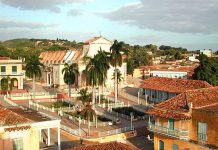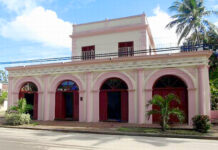
Contents
- 1 From its height, the Monument to Maximo Gomez, located at the roundabout of the Havana Tunnel, seems to protect the city.
- 2 Description of the Monument to Maximo Gomez
- 3 The Base of the Monument to Maximo Gomez
- 4 The Base of the Temple of the Monument to Maximo Gomez
- 5 The Temple of the Monument to Maximo Gomez
- 6 The Statue of the Monument to Maximo Gomez
From its height, the Monument to Maximo Gomez, located at the roundabout of the Havana Tunnel, seems to protect the city.
On May 1916, it took place an international contest to choose the design of monument to pay tribute to General Maximo Gomez. The Congress approved a budget of 200 thousand pesos for the execution of the monument.
In the contest was established that the monument would have to meet the specifics of equestrian sculptures: being a foreign national hero, should be looking out to sea and as Gomez had died a natural death, the horse should have all its paws on the floor. The call was open until 1919, and forty entries were submitted.
The jury chose the design almost unknown Aldo Gamba, a young Italian who lacked a major production that vouch for such consideration, a fact that led to heated controversies. However, the jury’s decision prevailed.
The culmination of the work was scheduled for 1925, but it was at risk due to the indolence of different governments during the economic and political crisis of those years.
Finally, after almost twenty years of being launched the initial idea, the majestic monument was inaugurated on November 18th, 1935, the 99th anniversary of the birth of the Generalissimo (The most important general) in his construction on Avenida del Puerto in a solemn ceremony.
Years later, the park surrounding the statue was modified and lost part of its original size due to the construction of the Havana tunnel.
Description of the Monument to Maximo Gomez
The sculpture was designed with a great monumentality, from a pyramidal composition of eminently classic character and combining groups of white marble and bronze.
The main architectural monument body rests on a large platform, with three staggered steps ascending to it and extending towards the front forming water ponds.
The Base of the Monument to Maximo Gomez
The monument to Maximo Gomez has a huge square base whose side walls are adorned continuous bas-reliefs that serve as allegory of the sacrifices of the people for a free homeland.
One of the side scenes outlines a procession of women with their children in arm as if to deliver them to lend the libertarian cause.
In the other scene you can see peasant figures who offer their goods and fruits to fight. The faces of both groups denote “serene attitudes and suffering”.
The figures of these bas-reliefs are classically dressed with tunics.
The contribution and sacrifice of the Cuban people devoted to the National Aurora, symbolized by another high area on the front of the base.
There opens a triumphal semicircular arch. From the arcade emerge the spirited horses of the sun, made in bronze, symbols of progress of the nation towards freedom and prosperity.
The interior of the basement houses the mausoleum containing the remains of the warrior. You can access this crypt by the back of the base by a bronze door that opens between columns.
An image of the country as a matron seated figure on the bronze door in the custody of the crypt of the hero.
The Base of the Temple of the Monument to Maximo Gomez
This second body of the monument is shaped by high estrcutures representing the Cuban Liberty. The triumphal march of the people is directed by an image of Victory with its wings spread.
In his right hand stands the torch of peace and freedom, while left brandishes an olive branch. Rigid male nudes are moving on foot and on horseback after Victory (inspired by the Victory of Samothrace).
They represent the liberating army. After them, women and children parade with flowers and receptions celebrating the victory.
The Temple of the Monument to Maximo Gomez
Above the central body of the monument, Gamba erected the Temple of the Homeland. This temple is rectangular, and is supported by fourteen Doric columns of white marble.
An eternal flame evokes the memory of the hero from an altar within the colonnade.
The Statue of the Monument to Maximo Gomez
On this pedestal and finishing off the assembly is the equestrian statue of General Gomez, who is wearing a uniform, with a sword in his belt and a hat in his right hand.
His steed is planted on its feet with the head and neck extended forward. The General contemplates the horizon denoting pride in the feat fought on for independence.







